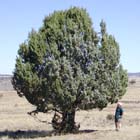
A large tree by Ritter Lookout in E Oregon [C.J. Earle, 2002.09.22].
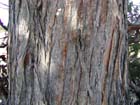
Bark of the above tree [C.J. Earle, 2002.09.22].
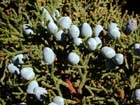
Seed cones on the above three [R. Van Pelt, 2002.09.22].
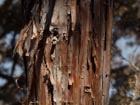
Bark on small trees and limbs (this is about 12 cm diameter) is red-brown and papery [C.J. Earle, 2013.12.21].

The foliage on this tree at a public park in Bend, Oregon has taken on a bronze color during the winter months [C.J. Earle, 2013.12.21].

Winter photo showing bronze foliage and pollen cones awaiting warmer weather [C. J. Earle, 2013.12.21].
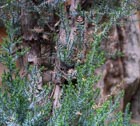
Juvenile foliage on a young plant in eastern Oregon [C.J. Earle, 2006.05.22].

The juniper invasion: comparison of historical and recent photos taken on the Keystone Ranch east of Prineville, Oregon (Miller et al. 2005).
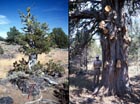
Illustration of the poor relationship between tree size and age. Both of these trees were sampled in southwest Idaho, in stands near each other and at comparable elevations. The tree at left, about 2.5 m tall and 20 cm dbh, proved to be about 500 years old. The tree at right, over 12 m tall and 140 cm dbh, was about 350 years old [C.J. Earle, 1985.07.02].
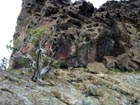
An old tree growing on welded tuff in the Lost Forest of central Oregon [C.J. Earle, 2006.05.22].

Many ranchers feel that junipers limit the potential for rangeland to produce cows, and extensive projects are performed to kill junipers using saws, bulldozers, brush cutters, herbicides, etc. Substantial public funds are spent on these schemes. This is near the John Day River in Oregon [C.J. Earle, 2012.05.20].

This tree in southeast Oregon was found to be over 1,100 years old [C.J. Earle, 1985.06.27].

A recent burn in western juniper on the southern ramparts of Steens Mountain, Oregon [C. J. Earle, 2019.06.11].

Another burn on Steens Mountain, showing where the fire moved upslope to the rimrock [C. J. Earle, 2019.06.11].

A subalpine tree clinging to the lip of Blitzen Gorge on Steens Mountain [C. J. Earle, 2019.06.11].

Conservation Status

Juniperus occidentalis
Hooker 1838
Common names
Western juniper (Peattie 1950).
Taxonomic notes
The closely related Juniperus grandis is sometimes classified as a subspecies, J. occidentalis Hook. subsp. australis Vasek 1966 or as a variety (Holmgren and Holmgren 1972). Leaf essential oil analyses address the relationships between these taxa and the closely related J. osteosperma. Adams et al. (2006), in raising J. grandis to species rank, argued that not only are there consistent morphological differences between the taxa, but that the molecular differences are significant as well. That analysis showed that J. grandis is sister to an occidentalis-osteosperma clade. In this connection it is worth noting that both J. occidentalis and J. grandis have been reported to hybridize with J. osteosperma in northwestern Nevada (Miller et al. 2005, Adams 1993). More recent work (Adams and Kauffmann 2010a, 2010b) has shown that the interspecific differences persist even in populations located quite close to each other, which further supports the concept of differentiation at the species rank.
The type was collected in 1826 by David Douglas, near the Columbia River. He described it as "Common on the higher parts of the Columbia, at the base of the Rocky Mountains." This collection was nearly at the northern limit of the species' range (Farjon 2005).
Some antique synonymy (Farjon 2005):
- Sabina occidentalis (Hook.) Antoine 1837
- Juniperus andina Nutt. 1849
- Juniperus pseudocupressus Dieck 1899
Description
Monoecious or dioecious (average 50% of each) evergreen trees 10-15(-30) m tall and 30-100(-250) cm dbh, usually single-stemmed. Branches thick, ascending or spreading, often curved or contorted, the foliage branches forming dense rounded tufts at the ends of the heavy main branches, forming a pyramidal crown in young trees, becoming rounded and irregular in old trees. Bark first smooth, pink-brown, then becoming grey and flaking; then fibrous, red-brown to brown, exfoliating in thin strips. Branchlets numerous, stout, 3-sided in cross section, (1.2-)1.5-2 mm thick, branching at 60° or less. Leaves dark green, abaxial glands oval, conspicuous, often with yellow or white exudate, margins denticulate (at 20×); whip leaves 3-6 mm, not glaucous adaxially; scale-like leaves in alternate whorls of 3, 2-3 × 2 mm, ovoid-rhombic, acute or obtuse, not overlapping, appressed. Pollen cones numerous, terminal on short ultimate branchlets, subglobose to ovoid-oblong, 3-5 × 2-3 mm, yellow-green maturing yellow-brown; microsporophylls (10-)12-16(-18). Seed cones maturing in 2 years, terminal on ultimate branchlets, initially 2 mm diameter with 4-6 spreading bracts, growing in two seasons from purple-red to blue or purple with a glaucous bloom, subglobose, ca. 7.5 mm diameter, fleshy or pulpy, more or less resinous, eventually dry, falling soon after ripe. Seeds 1-2 per cone, ovoid or semi-ovoid, 5-6(-7) × 4-5 mm, with shallow grooves and resinous pits, yellowish-brown. Cotyledons 2 (Adams 1993, Farjon 2005). See García Esteban et al. (2004) for a detailed characterization of the wood anatomy.
In eastern Oregon, cones are fertilized in April or May and mature during their first winter (Bedell et al. 1993).
Distribution and Ecology
USA: Washington, Oregon, Idaho, Nevada and California. See also Thompson et al. (1999). Occurs at elevations of 185-3050 m (Dealy 1990). Hardy to Zone 5 (cold hardiness limit between -28.8°C and -23.3°C) (Bannister and Neuner 2001).
Distribution of the primary serrate-leaf-margin Juniperus taxa of western North America; J. occidentalis shown in red. Click on any marker for more information and a link to the source.
Juniperus occidentalis represents the northwestern portion of the piñon and juniper region in the Intermountain West. See Pinus monophylla for a detailed discussion of this vegetation type. J. occidentalis has a range extent of approximately 3.6 million hectares (Miller et al. 2005), occurring at elevations of (185-)670-1525(-2500) m (Dealy 1990).
Climate is semi-arid continental, with dry hot summers, cold winters, and precipitation of 230 to 355 mm falling from fall to spring as rain or snow. The average temperature in January is -1°C and in July, 18°C, with extremes as much as 20° colder or hotter. Summer lightning storms are common and result in natural fires which have historically had a major influence on the species' distribution. Soils are highly variable but are generally of silicate origin, often weakly developed and stony; carbonate, where present, is usually depositional due to the dry climate. Soils in mature stands have elevated levels of Ca, K, and pH, factors that apparently confer a competitive advantage (Dealy 1990).
Western juniper often forms pure stands, or is associated with Pinus ponderosa or Cercocarpus ledifolius. Near its upper elevation limits, common associated trees include Abies concolor, Pinus contorta subsp. latifolia, Pinus ponderosa, and Pseudotsuga menziesii subsp. glauca. The most common shrub associate is Artemisia tridentata (sagebrush); other common shrubs include Chrysothamnus nauseosus, C. viscidiflorus, Purshia tridentata, Ribes cereum, and Tetradymia spp. (Dealy 1990).
Life history: Normally pollen is released in May, with cones maturing in September of the second season. A good cone crop is produced almost every year, so most trees bear two years' worth of cones. Seeds are dispersed during the fall and winter, and germinate in April (Dealy 1990). Western junipers primarily regenerate from seed, but trees less than about 60 years of age can also resprout from stems cut near the ground surface. Seeds are cast starting in their first winter and may be spread by gravity, wind, water, or a variety of animals, chiefly the common robin (Turdus migratorius) and Townsend's solitaire (Myadestes townsendi). Seedlings establish primarily in protected microenvironments under woody shrubs. They produce a deep taproot in the first decade of life, and thereafter send out long lateral roots that may extend as much as five times the height of young (<40 years) trees. Growth is slow until the trees are above the shrub layer (commonly 15-25 years) and then accelerates to up to 15 cm per year. Trees normally become fully reproductive when 2.5 to 3 m tall, commonly at about 75 years old. Sex expression is influenced by genome and stress; normally about 10% of trees produce only male cones, 40-50% produce only female cones, and the remainder have mixed composition. Stressed trees produce no cones or predominantly male cones, while in exceptionally benign conditions trees primarily produce female cones (Bedell et al. 1993).
This species is a host for the mistletoe Phoradendron juniperinum Engelm. ex A. Gray, shown in photos at right.
Juniper Invasion: Beginning in ca. 1870, western juniper woodlands in eastern Oregon and adjacent Idaho, Nevada and California began a rapid expansion into former shrub and grass dominated communities, and by the end of the 20th century had increased their range to more than three times the estimated coverage in the mid-1800s (Bedell et al. 1993). The time required for a new woodland to achieve stand closure is 70-90 years on cool wet sites and 120-170 years on dry warm sites (Miller et al. 2005). Various causes of this expansion have been suggested, including an optimal climate from about 1870 to 1915, and long-term overgrazing by cattle and sheep and suppression of natural fire regimes. The increased cover by juniper woodlands causes reduced cover by shrubs and herbs and a proportional increase in exposed soil. This has been tied to significantly increased rates of soil erosion - four times as great as on good condition grasslands, and about 15% more than on sagebrush lands (Bedell et al. 1993). Other ecological changes related to the expansion of juniper woodlands include reduced stream flows; reduced forage production; altered wildlife habitat; changes in plant community composition, structure, and biodiversity; and the replacement of mesic and semi-arid plant communities with woodlands (Miller et al. 2005). This has been very distressing to ranchers, who see juniper as a direct competitor to grass on an increasingly degraded range, and thus extensive efforts have occurred to "control" (i.e. kill) the invasive junipers with bulldozers, chains (a very large chain or cable dragged across the landscape between two bulldozers, uprooting all trees in its path), chainsaws, mechanical shears and whole tree chippers, and prescribed fire (Miller et al. 2005). These efforts have been controversial, partly because some of the control methods are perceived as highly destructive on the landscape, and partly because control is perceived as temporary and questionably effective either ecologically or economically (or both). Miller et al. (2005) provide a very responsible review of the many different sides to the question of whether juniper invasion should be controlled, and if so, then how to do it.
Death and Destruction: Historically, fire was likely the principal agent of mortality. Prior to maturity, the species is highly vulnerable to fire, and invasive stands of this age are most easily controlled by prescribed fire. Mature trees have some resistance to fire because they have little fuel near the stem and relatively thick bark, and because foliage is fairly high above the ground. The oldest stands, though, occur in relatively fireproof locations where sufficient fuels do not accumulate and the wide spacing betweent trees retards the spread of fire (Dealy 1990 and pers. obs.). Insect infestation has not been intensively studied in this species because it has relatively little commercial value, and severe infestations have seldom been observed. The juniper bark beetle (Phloeosinus serratus) can cause mortality, particularly to trees in a weakened condition, such as during drought. Gall midges feed on western juniper and produce galls (Dealy 1990). The principal fungal diseases include a white trunk rot (Pyrofomes demidoffii) that attacks living trees and an unidentified brown cubicle rot usually found in the basal portions of the trunk (Dealy 1990). I have observed that these fungi are common in fast-growing trees growing on relatively moist sites, but are rare in trees on severely dry sites. Fungi known to attack foliage include endophytic fungi Retinocyclus abietis anamorpha and Hormoneme sp. Infection rates increase with age, density, and purity of stands, but in general, western juniper is minimally susceptible to infection (Petrini and Carroll 1981 in Dealy 1990). Two mistletoes, Phoradendron ligatum and P. densom, cause lower vigor, deformity of branches, and brooming of the foliage. Brooming of foliage can also be caused by the stem rusts Gymnosporangium kernianum and G. betheli (Herbst 1978 in Dealy 1990).
Remarkable Specimens
The largest known specimens are two co-champions, both in Lake County, Oregon, both of which get 312 "points" under the usual system for measuring trees in the USA. One, the "Lost Forest Mammoth", was first recognized in 1973 by Art Kohfield, Maynard Drawson, Dr. Bernie Yenne and Bob Gabriel. Last measured in 2018, it was then 189 cm dbh and 20.7 m tall. The other co-champion has also been famous for a long time, mentioned and photographed by Jackman (1967). It was nominated to the Big Tree program by Bill Price in 2011 and last measured in 2016, as 180 cm dbh and 23.8 m tall (Barkley 2019, American Forests 2021, Jerry Black email 2023.06.20). A tree in the campground at Tumalo State Park, Oregon, was 24.4 m tall in 2013, and this is by a small margin the tallest specimen on record (Jerry Black email 2023.06.20). California's official "big tree" of J. occidentalis (UFEI 2023), which grows near the southern end of the zone where hybrids of the two species occur, appears to be a specimen of J. grandis, although it is marked as "Juniperus occidentalis" by an old Forest Service sign that predates the recognition of J. grandis as a distinct species.
The oldest sampled specimen was 1600 years old in 1999 (see Ethnobotany, below). This tree was visited and measured by Jerry Black in 2015, with a 97 cm dbh and 7.3 m tall, with a 4.5 m crown spread (Jerry Black email 2023.06.20).
Ethnobotany
A review of online sources indicates that the most common and universal use of the species is as fence posts, a fact that is abundantly clear if you travel through its range. A comprehensive review of uses of western juniper, by native peoples, by historical Euroamericans, and in prospective future use, is provided by Miller et al. (2005). Some of their points include:
- The Northern Paiute Indians used western juniper for food, medicine, and shelter. Extracts were used to treat colds, sore throats, venereal disease, kidneys, and boils. The berries were prepared for use during food shortages. The pitch was used to waterproof baskets. Some wickiups were built from western juniper.
- Early settlers used western juniper for fenceposts and firewood.
- Historically tested uses included pencil stock, treated and untreated posts, extractive oils, use for composites, chips for particle-flake board and animal bedding, commercial biomass firewood, decking, interior paneling, doors, cabinetry, rustic furniture, picture frame molding, small gifts, Christmas decorations, and as flavoring for gin. In general, these uses have had limited succes. A substantial amount of western juniper boughs and berries, estimated at minimum in the hundreds of tons, is also harvested seasonally for the holiday wreath industry.
- Commercial uses of western juniper will probably not make significant contributions to plant community restoration in the western juniper ecosystem on a landscape basis without financial incentives to harvest. In most cases there are cheaper wood fiber substitutes readily available.
With regard to the last point: a lot of money is currently spent to remove trees due to perceived economic or ecological impacts (see "Juniper invasion" above). To the extent those costs can be offset by forest product recovery, use of the species may become more feasible in the future.
With regard to scientific uses, this species has proven particularly useful in dendroclimatology; many collections are tabulated by Holmes et al. (1986). Rick Miller, researcher out of Oregon State University, reports (e-mail 1999.07.30) "The oldest western juniper (var. occidentalis) we have aged to date is 1600 yrs (solid to pith). We have aged around a dozen that are between 1,000 and 1,500 years. These are living trees and have been working with the tree ring lab at Univ. of Ariz. to develop a master chronology. There are probably older trees but it is very difficult to find old trees solid enough to age to the pith. Working with Chris Baisan and Dave Meko from the lab we have cross dated standing dead trees with pith dates going back to around 100 BC. These trees have been dead for 500 to 600 years."
Observations
Western juniper can be seen widely in the West, notably at the Juniper Dunes Wilderness in WA (near its northern range limit) and throughout much of E Oregon, SW Idaho and NW Nevada. Once you are north or west of the range of Juniperus osteosperma, it is by far the most common juniper on the landscape, and I strongly suspect it is the most common tree in Oregon; indeed, over vast areas of the state, it is the only tree.
Remarks
The epithet occidentalis means "western".
Citations
Adams, Robert P. 1993. Juniperus. Flora of North America Editorial Committee (eds.): Flora of North America North of Mexico, Vol. 2. Oxford University Press. This document is available online. Go to http://www.efloras.org, click on "Flora of North America," and search for "Juniperus."
Adams, R. P., S. Nguyen, J. A. Morris and A. E. Schwarzbach. 2006. Re-examination of the taxonomy of the one-seeded, serrate leaf Juniperus of southwestern United States and northern Mexico (Cupressaceae). Phytologia 88(3):299-310.
Adams, Robert P., and Michael E. Kauffmann. 2010a. Geographic variation in the leaf essential oils of Juniperus grandis and comparison with J. occidentalis and J. osteosperma. Phytologia 92(2):167-185.
Adams, Robert P., and Michael E. Kauffmann. 2010b. Geographic variation in nrDNA and cp DNA of Juniperus californica, J. grandis, J. occidentalis and J. osteosperma (Cupressaceae). Phytologia 92(2):266-276.
American Forests 2021. 2021 National Register of Champion Trees. https://www.americanforests.org/champion-trees/champion-trees-registry/, accessed 2023.06.26.
Barkley, Yvonne. 2019. Idaho's Registry of Champion Big Trees. https://sites.stat.washington.edu/jaw/CAW/june-2019-id-registry-big-trees.pdf, accessed 2023.06.26.
Bedell, T. E., L. E. Eddelman, T. Deboodt, and C. Jacks. 1993. Western Juniper -- Its Impact and Management in Oregon Rangelands. Publication EC 1417, Oregon State University Extension Service. 16pp.
Dealy, J. E. 1990. Western juniper, in Burns and Honkala (1990).
Herbst, John R. 1978. Physical properties and commercial uses of western juniper. P. 169-177. in R.E. Martin, J.E. Dealy, and D.L. Caraher (eds.), Proceedings, Western Juniper Ecology and Management Workshop. General Technical Report PNW-74. Portland, OR: Pacific Northwest Forest and Range Experiment Station.
Holmgren, A. H. and N. H. Holmgren. 1972. Intermountain Flora 1: 239.
Hooker, William Jackson. 1838. Flora Boreali-Americana 2 (10): 166.
Jackman, E. R. 1967. The Oregon Desert. Caldwell, ID: Caxton. 407 pp.
Miller, R. F., J. D. Bates, T. J. Svejcar, F. B. Pierson, and L. E. Eddleman. 2005. Biology, Ecology, and Management of
Western Juniper (Juniperus occidentalis). Oregon State University Agricultural Experiment Station Technical Bulletin 152. 82pp. (Highly recommended. Can be found on the Web.)
Petrini, Orlando, and George Carroll. 1981. Endophytic fungi in foliage of some Cupressaceae in Oregon. Canadian Journal of Botany 59:629-636.
UFEI. 2023. California Big Trees. https://californiabigtrees.calpoly.edu/bt-tree-detail/496, accessed 2023.08.06.
See also
Burns and Honkala (1990).
Johnson, D.D. and R.F. Miller. 2006. Structure and development of expanding western juniper woodlands as influenced by two topographic variables. Forest Ecology and Management 229(1-3): 7-15.
Lanner (1983).














